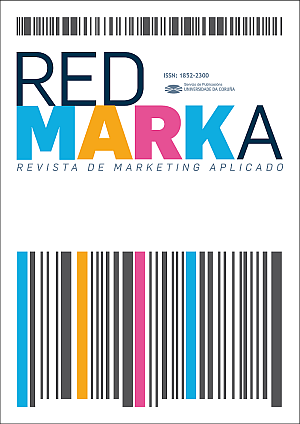Aplicación de las herramientas de comunicación a un evento turístico: el caso Xacobeo
Contenido principal del artículo
DOI:
https://doi.org/10.17979/redma.2010.01.04.4707Resumen
El objetivo del presente trabajo consiste en analizar la importancia que para un destino turístico como Galicia ha supuesto la creación de un evento como es el Xacobeo. Para ello se estudian las distintas herramientas de comunicación empleadas en la promoción de los tres eventos celebrados hasta hoy: Xacobeo 93, Xacobeo 99 y Xacobeo 04, con la finalidad de determinar la repercusión de las mismas en todo el proceso de la comunicación como variable del marketing operativo, y destacar la importancia y eficacia de cara a su posterior aplicación en la celebración de nuevos eventos como en el caso del actual Xacobeo 2010.
Palabras clave:
Detalles del artículo
Referencias
Aguirre, M.S. (coord.) (2000): Marketing en sectores específicos. Pirámide. Madrid.
Alén, M.E., Fraiz, J.A., y Mazaira, A. (2007): “Presión de tempo e contido informativo das promocións de vendas”. Revista Galega de Economía, vol. 16, nº 1, pp. 95-110.
Altés, C. (1993): Marketing y turismo. Introducción al marketing de empresas y destinos turísticos. Síntesis. Madrid.
Ascanio, A. (1991): “Turismo como sistema de servicios: soportes físicos y estrategias”. Papers de Turisme, n.º 6, pp. 35-50.
Ashworth, G.J. (1991): “Products places promotion: destination images in the analysis of the tourism industry” en The Tourism industry: an international analysis. Sinclair, M.T y Stabler, M. J. Eds., pp. 121-142. Cab International, U.K.
Bello, L.; Vázquez, R. y Trespalacios, J.A. (1996): Investigación de mercados y estrategia de marketing. Civitas. Madrid.
Bigné, E., Font, X., y Andreu, L. (2000): Marketing de destinos turísticos. Análisis y estrategias de desarrollo. ESIC. Madrid.
Bigné, E. (2003): Promoción comercial, ESIC, Madrid.
Broackes, J. (2009): “David Hume”, en HONDERICH, T., Los filósofos, Tecnos, Madrid.
Buhalis, D. (2000): “Marketing the competitive destination of the future”. Tourism Management, n.º 21, pp. 97-116.
Colectivo de autores (2003): Enciclopedia práctica profesional de turismo, hoteles y restaurantes. Océano, Barcelona.
Díez, E.C. et al. (2002): Marketing, investigación, investigación comercial. Pirámide. Madrid.
Elizagarate, V. (2003): Marketing de ciudades. Pirámide. Madrid.
Go, F. (1992): “El paradigma de los nuevos productos turísticos y las ventajas competitivas”. Revista Valenciana d`Estudis Autonòmics, n.º 13, pp. 75-102.
Goodall, B. (1990a): “The dynamics of tourism place marketing”. Marketing tourism places. Ashworth, G. y Goodall, B. Eds., pp. 259-279. Routledge, London.
Goodall, B. (1990b): “How tourists choose their holidays: an analytical Framework” en B. Goodall y G. Ashworth (eds.): Marketing in the Tourism Industry: The Promotion of Destination Regions”, Routledge, London, pp. 1-17.
Heath, E., y Wall, G. (1992): Marketing tourism destinations. A strategic planning approach. John Wiley & Sons, USA.
Kotler, P. (1989): Principles of marketing. Prentice-Hall, Englewood Cliffs, Nueva Jersey.
Lois, R.C., y Santos X.M., (1997): “Galicia”. La actividad turística española en 1996. Asociación Española de Expertos Científicos en Turismo (AECIT). Madrid.
Martín, E. (1980): La gestión publicitaria, Pirámide, Madrid.
Martínez, V.A. (2004): “Comunicación por Acción: Patrocinio y Mecenazgo”, en BEL, I. (coord), Comunicar para crear valor. La dirección de comunicación en las organizaciones, EUNSA, Pamplona.
Martínez, V.A., Juanatey, O., y Blázquez, F. (2004): “Efectos de la corrupción en la imagen percibida de las empresas”, Revista de Estudios de Comunicación ZER, Bilbao, pp. 45-66.
Martínez, V.A., Juanatey, O., Orosa, J., y Rodríguez, L. (2004): “Estrategias de comunicación en la gestión de la responsabilidad social de la empresa”, II Encuentro IberoAmericano sobre Estrategias de Comunicación, Sevilla, 16 de septiembre de 2004.
Massoni, S. (2007): Estrategias. Los desafíos de la comunicación en un mundo fluido, HomoSapiens, Rosario (Argentina).
Maure, G. (2007): “Definiciones y tendencias del turismo de eventos”, Contribuciones a la economía, n.º 82, julio 2007.
Middleton, V. (1994): Marketing in travel and tourism. Butterworth Heinemann, Oxford.
Milio Balanzá, I (2004): Diseño y comercialización de productos turísticos locales y regionales, Thomson-Paraninfo, Madrid.
Pérez, R.A. (2001): Estrategias de comunicación, Ariel, Barcelona.
Reinares, P., y CALVO, S. (1999): Gestión de la comunicación comercial. McGraw-Hill. Madrid.
Rey, M., et al. (2004): Fundamentos de marketing turístico. Síntesis. Madrid.
Rodríguez, I.A., De la Ballina, J., y Santos, L. (1997): Comunicación comercial: conceptos y aplicaciones. Civitas. Madrid.
Royo, M. (2002): Comunicación publicitaria: un enfoque integrado y de dirección. Minerva Ediciones. Madrid.
Rufín, M. (2002): Marketing (conceptos, instrumentos y estrategias). UNED. Madrid.
Serra, F.M. (2009): “Cómo dirigir en lo fluido: dinámica de sistemas”, en PÉREZ, R.A. y MASSONI, S., Hacia una teoría general estratégica, Ariel, Barcelona.
Sleight, S. (1992): Patrocinadores. Un nuevo y eficaz sistema de marketing. McGraw- Hill. Madrid.
Valls, J.F. (1992): La Imagen de marca de los países. McGraw-Hill. Madrid.
Woolhouse, R. (2009): “Locke”, en HONDERICH, T., Los filósofos, Tecnos, Madrid.
Xunta de Galicia (1994): Xacobeo 93. Santiago de Compostela.
Zeithmal, V.A. (1988): “Consumer perceptions of price and value: A mensend model and synthesis of evidence”, Journal of Marketing, vol. 52, (julio), pp. 2-22.
Zeithmal, V.A., y Bitner, M.J (2000): Marketing de servicios. McGraw-Hill. 2.ª edición. México.


